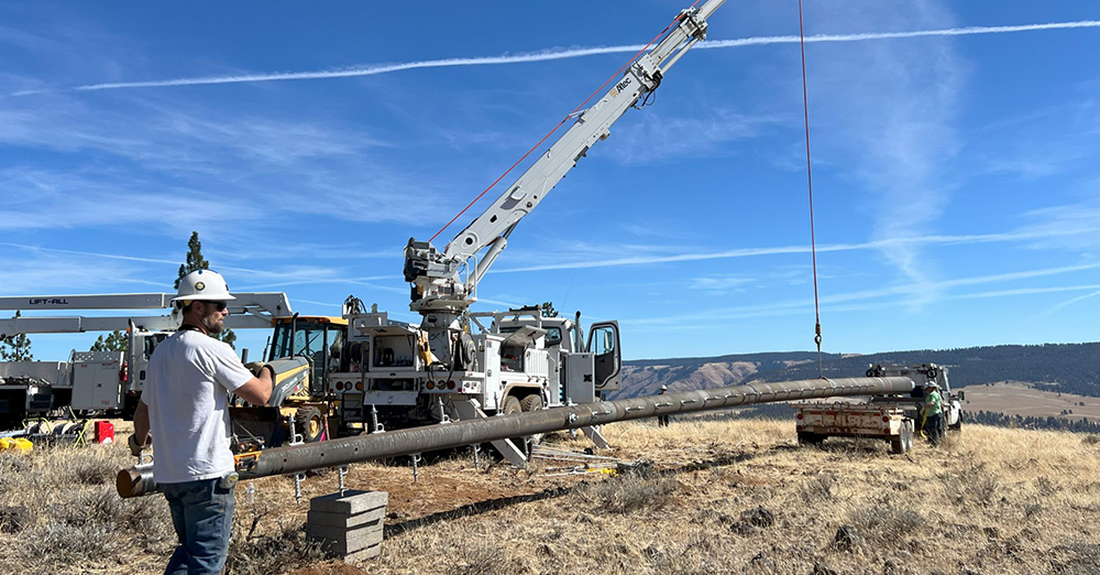
Power companies and municipalities face logistical and technical difficulties when replacing utility poles. Utility poles support power lines, which deliver electricity to homes, businesses, and industrial operations. Addressing the challenges associated with replacing utility poles involves careful planning—especially when dealing with aging infrastructure, environmental factors, and potential service disruptions.
The Issue of Aging Infrastructure
Utility poles face long-term exposure to environmental conditions, leading to deterioration over time. Many poles in use today have been standing for several decades, causing them to no longer meet modern safety standards.
Replacement becomes necessary to maintain reliable service. Power companies must account for the structural integrity of older poles and ensure that new installations can handle current power demands.
At McWane Poles, we provide high-quality utility poles that meet modern industry standards, helping to address challenges with replacing utility poles. We design our ductile iron poles to withstand environmental conditions while supporting the needs of expanding power grids.
Outdated materials and poles placed in regions with significant weather exposure become prone to damage. Wear and tear poses potential safety risks requiring repair before failures occur. Timely replacements allow electrical grids to function smoothly so that customers do not experience unexpected outages.
Safety and Compliance Standards
Power companies must replace older poles to meet current safety codes and regulations as part of the grid’s long-term maintenance. Many legacy poles in rural areas or smaller municipalities may no longer comply with evolving safety standards, requiring companies to install new poles with greater strength and durability. Power companies must continuously monitor the condition of poles across their service areas to ensure reliability.
Environmental Factors That Complicate Replacements
Extreme weather conditions complicate the replacement process. Regions prone to hurricanes, heavy snowfall, or high winds often experience more frequent pole replacements. Crews may face dangerous conditions when replacing poles in these areas, requiring additional safety precautions. Time-sensitive repairs often become necessary after major storms, putting further strain on resources.
Utility poles face significant stress in areas with intense weather patterns. Strong winds compromise utility poles, increasing the risk of damage to the electrical grid. Similarly, snow buildup and ice accumulation cause poles to weaken over time, and coastal regions also present unique challenges.
High humidity, saltwater exposure, and severe storms can wear down poles’ structural integrity faster than inland locations. Power companies must prioritize replacements when poles deteriorate under these conditions to avoid larger grid failures.
Remote and Urban Challenges
Terrain challenges can arise in rural areas. Utility poles in remote or mountainous regions may require specialized equipment for transportation and installation. In some cases, traditional trucks and cranes cannot access remote poles, which can delay the replacement process.
Workers often need helicopters or off-road vehicles to reach these poles. The added complexity of transporting materials increases costs and makes it harder for power companies to replace aging infrastructure quickly.
Urban environments also present obstacles since poles often stand near buildings or underground utilities, requiring extra caution during replacement projects. Power companies must navigate these obstacles carefully. Cities have dense utility networks, making it difficult to isolate specific poles for replacement without disrupting other services.
Roads, sidewalks, and buildings create tight spaces, making pole removal and replacement challenging. In many cases, workers must temporarily close streets or reroute traffic to safely complete replacements, which increases the inconvenience for local residents.
Minimizing Service Disruptions During Replacements
Maintaining electrical service during pole replacements is essential. Power outages inconvenience residents and businesses and can cause potential economic losses.
Power companies plan carefully to minimize disruptions by scheduling replacement work during off-peak hours. They must also communicate effectively with customers to provide clear information about potential outages.
Furthermore, companies often create temporary service reroutes to keep power flowing while replacing poles. Coordinating with local governments and residents ensures replacement projects progress smoothly without unnecessary delays or complaints.
Replacing poles safely and efficiently helps reduce the risk of prolonged service interruptions. Careful planning and strategically placing replacement poles help prevent future outages while improving overall grid reliability. Power companies work to reduce the risk of extended blackouts or brownouts by conducting regular maintenance and monitoring the grid’s condition.
The Importance of Sourcing Reliable Materials
Sourcing high-quality poles remains crucial for avoiding future replacements and ensuring the longevity of the electrical infrastructure. Reliable materials lead to fewer disruptions, longer service life, and reduced maintenance needs. The type of material chosen for utility poles is crucial for longevity.
Although traditional wood poles are common, they may no longer be the best solution in many environments. Poles using newer materials, such as steel or ductile iron, offer superior resistance to environmental wear and require less maintenance. Companies must weigh the pros and cons of different materials based on the conditions surrounding the installation.
Well-functioning power companies rely on trusted power pole suppliers to provide durable poles that meet their needs. At McWane Poles, we understand the importance of sourcing materials that ensure long-lasting performance in diverse environments. We craft our utility poles to withstand the rigors of everyday exposure, helping to support the electrical grid efficiently.
Planning for the Future of Electrical Grids
Modern power grids must accommodate increasing demand as urbanization and energy consumption grow. Replacing utility poles requires not only the installation of new structures but also planning for future grid expansion. Power companies must ensure that new poles can support both current and future energy needs.
At McWane Poles, we help address these challenges by offering durable ductile iron poles that support growing electrical networks. Our solutions help power companies plan for the future while meeting today’s operational demands.
As power consumption continues to rise, power companies must ensure that their infrastructure can handle increased demand. Planning for future growth involves installing poles that can bear heavier loads and support expanding electrical grids.
Meeting the Challenges
Replacing utility poles is one of the largest maintenance tasks for modern power companies. The challenges associated with this task include addressing aging infrastructure, adapting to environmental conditions, minimizing customer disruptions, and sourcing reliable materials.
Meeting these challenges head-on ensures that the grid continues to function safely and efficiently for years to come. Power companies that proactively address these challenges can improve grid reliability and reduce the risk of costly failures in the future.

